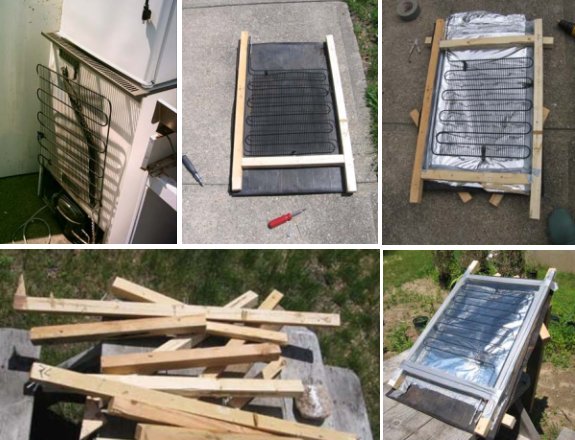
Ultra low budget do it yourself solar water heater

This low budget solar water
heater could be made for free if you're good at scrounging material and
taking advantage of scrap pieces.
I've been thinking of making
a modified version of the one above that would link two or maybe three
refrigerator coil grids together with a small pump.
Image credit belongs to the
online community of Sietch.org.
Want more in-depth information? Browse through our books.
Or explore more posts by date or by subject.
About us: Anna Hess and Mark Hamilton spent over a decade living self-sufficiently in the mountains of Virginia before moving north to start over from scratch in the foothills of Ohio. They've experimented with permaculture, no-till gardening, trailersteading, home-based microbusinesses and much more, writing about their adventures in both blogs and books.
Want to be notified when new comments are posted on this page? Click on the RSS button after you add a comment to subscribe to the comment feed, or simply check the box beside "email replies to me" while writing your comment.

Solar water heaters are quite a mature technology. Study existing designs closely, so you don't have to re-invent the wheel.
You can even make one without a pump, as long as you mount the water tank above the collector. The principle is called a thermosiphon. You might want to go with a bigger pipe diameter in that case, though.
And I think you should insulate the back and sides of the collector, as well as the tank. Especially for the winter, as you don't want the system to freeze!
Alternatively, there are simple rubber profiles available that allow you to build a huge collector pretty simply. These are mostly used for swimming pools, but put them in a box and I'd think they'd work for hot water as well.
You might want to think about putting a heat exchanger in the hot water tank of the collector to prevent problems with bacterial and algae growth in your drinking water. And it would enable you to use a different working fluid for the collector (e.g. add some antifreeze).
Making it winterproof would be an extra effort. Although that same effort would also make it more efficient in the summer, so you could get by with a smaller collector or get more/hotter water.
Of course for it to work well in winter you'd have to keep it snow-free.
One of the better ideas seems to be to combine the collector with a PV panel. This gives you a double advantage;
I was thinking you should be able to build a really good solar water heater by turning a fridge "inside out". Rip the door off an old fridge, paint it black inside and put a sheet of clear plastic plate on instead of the door to keep heat in. Point it at the sun. Immerse the radiator on the outside of the fridge in the water you want to heat. Ideally you should add a PV panel to power the fridge's pump. Since a fridge is a heat pump that gives off its heat at a higher temperature that it collects, it should be more efficient. It could become too hot for the fridge to work properly, though.
Another idea that makes a solar collector more efficient is to use heat pipes. This is a closed pipe filled with a medium that evaporates easily when heated. The bottom of te pipe is in the solar collector, and the top of the pipe is inside the water tank. The sun heats up and evaporates the medium. It condenses in the relatively cooler end of the pipe, and runs down where the cycle begins again. The really cool thing (pardon the pun) is that a heat pipe is like a one-way street for heat transfer; it can only transfer heat in one direction (the relatively cool liquid only exists in the bottom of the pipe, away from the water tank), and unlike a normal water circuit it cannot transport heat from the water reservoir to the collector. You do need a special medium like a solvent that evaporates easily, or a compressed gas.
A heat pipe can be as simple as a piece of copper tube with a cap soldered on one end and a filler connector soldered to the other end. Everone who has ever worked with copper water tubing should be able to manage it.
Do you know who they fill regrigerators when they are made? The circuit is filled through a thin copper tube. When the coolant is in, the pipe is clamped shut, cut and soldered. Pretty simple.
A heat pipe is a closed system. The working fluid (which doesn't need to be a solvent, but a lot of them are good candidates) is contained inside the pipe.
It works purely by evaporation and condensation in a closed pipe.
You could even try it with water. But the sunny end of the pipe would need to get pretty hot to make the water evaporate fast.